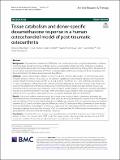Tissue catabolism and donor-specific dexamethasone response in a human osteochondral model of post-traumatic osteoarthritis
Author(s)
Black, Rebecca M.; Flaman, Lisa L.; Lindblom, Karin; Chubinskaya, Susan; Grodzinsky, Alan J.; Önnerfjord, Patrik; ... Show more Show less
Download13075_2022_Article_2828.pdf (3.323Mb)
Publisher with Creative Commons License
Publisher with Creative Commons License
Creative Commons Attribution
Terms of use
Metadata
Show full item recordAbstract
Abstract
Background
Post-traumatic osteoarthritis (PTOA) does not currently have clinical prognostic biomarkers or disease-modifying drugs, though promising candidates such as dexamethasone (Dex) exist. Many challenges in studying and treating this disease stem from tissue interactions that complicate understanding of drug effects. We present an ex vivo human osteochondral model of PTOA to investigate disease effects on cartilage and bone homeostasis and discover biomarkers for disease progression and drug efficacy.
Methods
Human osteochondral explants were harvested from normal (Collins grade 0–1) ankle talocrural joints of human donors (2 female, 5 male, ages 23–70). After pre-equilibration, osteochondral explants were treated with a single-impact mechanical injury and TNF-α, IL-6, and sIL-6R ± 100 nM Dex for 21 days and media collected every 2–3 days. Chondrocyte viability, tissue DNA content, and glycosaminoglycan (sGAG) percent loss to the media were assayed and compared to untreated controls using a linear mixed effects model. Mass spectrometry analysis was performed for both cartilage tissue and pooled culture medium, and the statistical significance of protein abundance changes was determined with the R package limma and empirical Bayes statistics. Partial least squares regression analyses of sGAG loss and Dex attenuation of sGAG loss against proteomic data were performed.
Results
Injury and cytokine treatment caused an increase in the release of matrix components, proteases, pro-inflammatory factors, and intracellular proteins, while tissue lost intracellular metabolic proteins, which was mitigated with the addition of Dex. Dex maintained chondrocyte viability and reduced sGAG loss caused by injury and cytokine treatment by 2/3 overall, with donor-specific differences in the sGAG attenuation effect. Biomarkers of bone metabolism had mixed effects, and collagen II synthesis was suppressed with both disease and Dex treatment by 2- to 5-fold. Semitryptic peptides associated with increased sGAG loss were identified. Pro-inflammatory humoral proteins and apolipoproteins were associated with lower Dex responses.
Conclusions
Catabolic effects on cartilage tissue caused by injury and cytokine treatment were reduced with the addition of Dex in this osteochondral PTOA model. This study presents potential peptide biomarkers of early PTOA progression and Dex efficacy that can help identify and treat patients at risk of PTOA.
Date issued
2022-06-10Department
Massachusetts Institute of Technology. Department of Biological Engineering; Massachusetts Institute of Technology. Department of Mechanical Engineering; Massachusetts Institute of Technology. Department of Electrical Engineering and Computer SciencePublisher
BioMed Central
Citation
Arthritis Research & Therapy. 2022 Jun 10;24(1):137
Version: Final published version